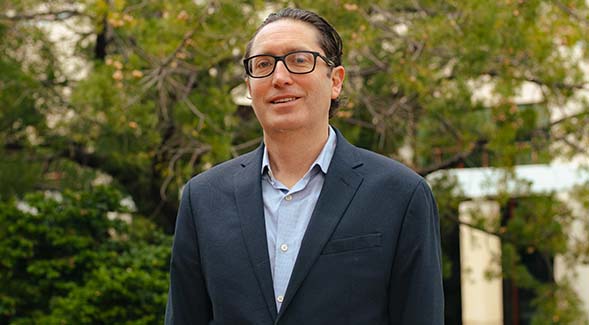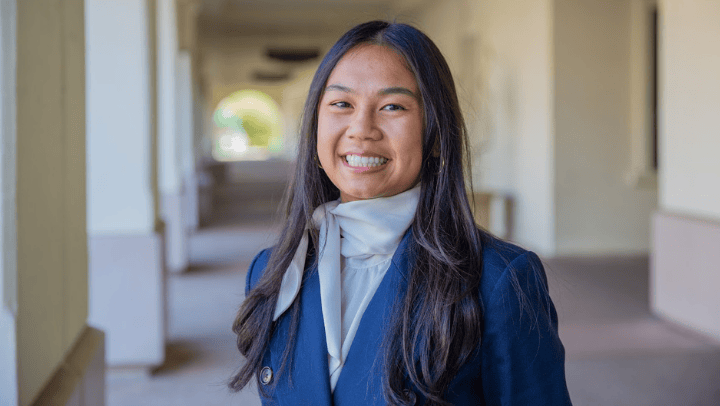Embracing Fivey-One: NSF CAREER Award Explores How Kids Learn Math
Assistant Professor Nicholas Johnson hopes to add nuance to an understanding of what good instruction looks like

Nicholas Johnson fervently bucks the conventional wisdom that young children need to learn basic skills by rote before they can start to problem solve and make sense of larger mathematical concepts.
“That's just not true,” asserts Johnson, an assistant professor in San Diego State University’s School of Teacher Education and the recipient of a notable National Science Foundation award for promising young faculty.
An expert in children’s mathematical thinking, Johnson is riffing now, recounting an interaction with a preschooler who was learning to count above 20.
“This little guy gets to 49 and he stops and goes, ‘Wait, what's it called? Fivey! Fivey-one, fivey-two, fivey-three, fivey-four,” Johnson says, laughing. “I was like, ‘Dude, that's the big idea here!’ It’s not that it's ‘fifty’ and not ‘fivey.’ The important math is that there's a pattern to the decade names and you use them in combination with the one-through-nine sequence and make the numbers keep going.”
A teacher focusing on correcting “fivey” rather than rewarding the thinking would have sent the 4-year-old the wrong message, Johnson said, “that you don't have to make sense of it — that your ideas don't matter.”
Johnson’s passion for recognizing and cultivating children’s innate mathematical abilities has led him to a major achievement: a $1 million NSF Faculty Early Career Development (CAREER) Award to investigate young children's opportunities to learn mathematics in early childhood classrooms. He is the first College of Education faculty member in more than a decade to receive the NSF’s most prestigious award for early-career faculty.
Uncovering Nuance
Johnson’s project will follow 15 children over three years as they advance through preschool, transitional kindergarten (TK) and kindergarten.
He’ll observe individual children’s experiences in classrooms that attempt to take up innovative approaches to mathematics — those designed to elicit and build from children’s thinking — with an eye on how historic patterns of participation and exclusion may or may not reproduce themselves even in “ideal” settings. Johnson also hopes to bring greater attention toward what preschool teachers do well in hopes of effecting change in elementary education, an important consideration as California works to roll out a PK-3 Early Childhood Specialist Instruction Credential.
In sum, he’s looking to develop a more nuanced understanding of how individual children’s opportunities to learn play out over time as they progress through early childhood.
“We have a lot of evidence that, for example, inviting young children to count collections or to solve story problems can provide potentially transformative early learning experiences, but my hope is that we have a lot more to say about the ‘it depends' part of it.” Johnsons said. “Like, does it matter if you get encouraged to go with ‘fivey' versus getting corrected every time you count in a nonstandard way?
“These might seem like little details, but we know that the details of interactions really matter for what children learn and who they get to become in school. So little details can end up having big implications for teacher education and professional development and, potentially, policy.”
Turning Point
Johnson was once the model of a far more traditional elementary school math teacher in the way he prepared, structured, and presented lessons.
Deep down, however, Johnson doubted his students were actually grasping the deeper concepts. While teaching long division to fifth graders in Gardena, California, an instructional coach observed his classroom and confirmed his worst fears.
"He basically called out what I knew was happening but had sort of chosen to ignore. He said, ‘Yeah, they're completing the problems, but they don't really understand anything about what they’re doing.’”
As much as it stung, the critique awakened Johnson to the fact that he had more to learn. Johnson went on to become a math coach himself at a school in Los Angeles, and then a program specialist in Orange County. Along the way, he visited classrooms where the math looked very different, becoming fascinated with a student-centered approach called Cognitively-Guided Instruction (CGI).
“The teachers were running the classroom but the kids were running the math,” he said. “I kind of got obsessed.”
Entering Academia
Obsession led to a big leap of faith. With a wife and two young children, Johnson decided to leave his comfortable county job and pursue a Ph.D. at UCLA so he could work with professor Megan Franke, a pioneer in CGI.
The payoff came in 2019 when Johnson was hired to a tenure-track position at SDSU, giving him a chance to rub elbows with renowned mathematics educators such as Randolph Philipp, Lisa Lamb, Melissa Soto and Victoria Jacobs, who he regarded as a “hero” during his time in Orange County.
“I was supported by a lot of people at SDSU to get this NSF CAREER award,” he added. “I don’t think this would have happened at another institution — and it wouldn't have happened without the really significant investment that other faculty make in junior faculty's success here."
Listen to a podcast featuring Nick Johnson and associate dean for research Rachel Haine-Schlagel



